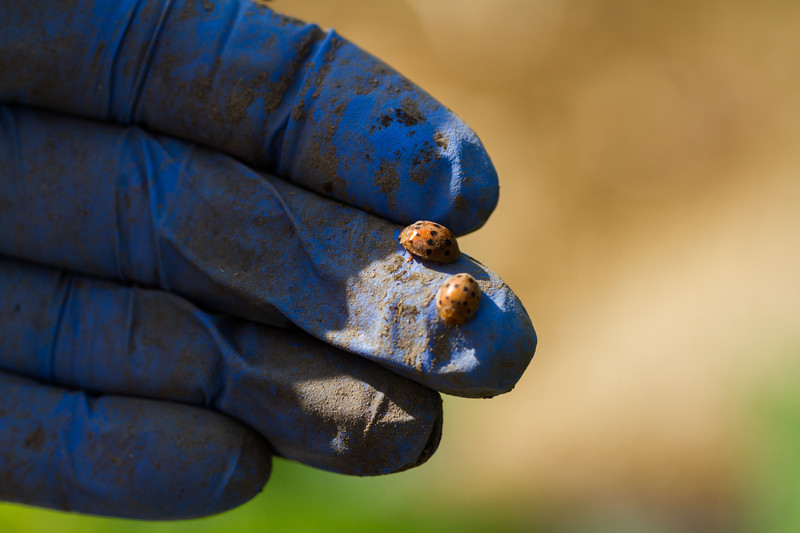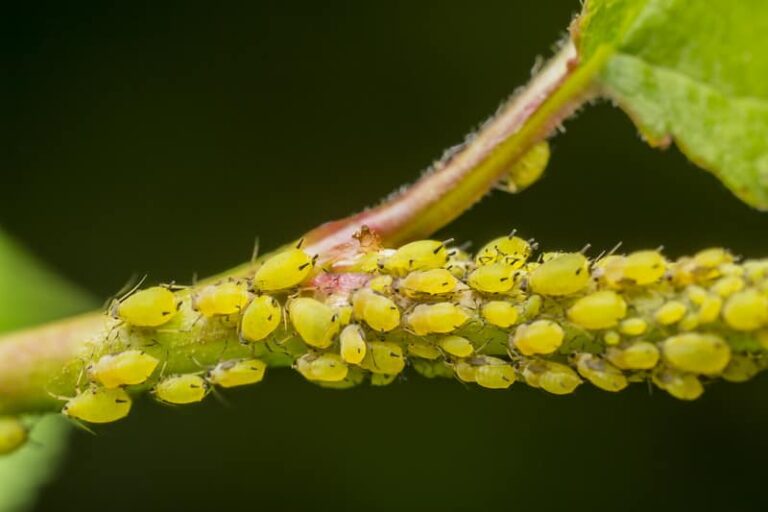Mexican Bean Beetle Organic Pest Control
Adult Mexican bean beetles are oval yellowish-brown to copper-colored beetles with 16 black spots on their wing covers. They are ¼-inch long and look something like a ladybug.
Bean beetle larvae are fat yellowish or orange humpbacked grubs with long branching spines 5/16-inch long.
Mexican bean beetle larvae and adults feed on snap beans, lima beans, soybeans, mung beans, and cowpeas. They can skeletonize leaves and leave plants severely defoliated. They also sometimes eat bean-family flowers and fruits.

Good Products for Pest and Disease Control at Amazon:
- Garden Safe Snail and Slug Bait
- Bonide Sulfur Fungicide
- Monterey BT Caterpillar Killer
- Neem Bliss 100-% Cold Pressed Neem Oil
- Safer Brand Insect Killing Soap
- PyGanic Botanical Insecticide
Mexican bean beetles are a species of lady beetles (ladybugs) but unlike beneficial species of lady beetles which feed on pest insects, bean beetles attack and can destroy target plants. Bean beetles can travel long distances to find new sources of food.
Adult bean beetles overwinter in garden debris and weedless fields then emerge from dormancy in late spring when temperatures reach the 60°sF. Adult females lay clusters of 50 to 75 yellow, oval eggs on the undersides of bean plant leaves. The eggs hatch in 5 to 14 days and the larvae then feed for a few weeks before pupating under the leaves.
Bean beetles are most active during midsummer. In warm regions, there are four generations of Mexican bean beetles each year.
Bean beetles are found throughout the United States especially in the East and in moister regions of the West.
Scientific name: Epilachna varivestis
Target plants
Mexican bean beetle larvae and adults feed on snap beans, lima beans, soybeans, mung beans, and cowpeas. They also attack summer and winter squash.
Feeding habits and damage
Adults and larvae feed on the lower surfaces of leaves, skeletonizing the leaves. Large infestations will feed on bean pods and stem. They leave characteristically lacy damage to leaves. Severe defoliation may kill plants.
Organic controls
Handpick larvae and adults daily in small bean patches. Cover plants with floating row cover until plants are large enough to withstand damage. Spray severe infestations weekly with neem or pyrethrin.
Organic control calendar
Here is what you can do seasonally to control Mexican bean beetles:
- Before planting: Turn under bean crop residues. Grow a trap crop of bush lima beans which will attract bean beetles; then handpick and destroy them. Attract beneficial predators to the garden by planting dill, parsnips, Queen Anne’s lace, and white clover. Release spindled soldier bugs to control early generations of bean beetles; release parasitic wasps when the weather warms. Plant early-season bush beans to avoid main beetle generations.
- At planting time: Plant your main bean crop early in the season or late in the season; to avoid the most destructive generations of bean beetles. Sprinkle a diatomaceous earth barrier around each plant; you can also dust stems and leaves. Place spun poly row covers over plants to exclude beetles; lay the cover directly on the plants and seal the edges at the ground with soil. Place aluminum foil sheets around the base of plants; beetles will see blue sky reflected in the foil and fly past the green bean plants.
- While crops develop: Handpick and crush eggs–groups of 40 to 60—found on the undersides of leaves. Handpick beetles and crush them between your fingers or drop them into soapy water. If the infestation gets out of control, use pyrethrum. Pyrethrum paralyzes bean beetles on contact; make two applications three days apart.
- After harvest: Fall cleanup can greatly reduce the population of bean beetles in the garden the following growing season. Pull up all infested plants as soon as the harvest is finished; put the vines in a clear plastic bag and place the bag in the sun for a week or so; the beetles will not survive. Leave the soil bare after cleanup so that birds can eat any beetles that remain.
Natural predators
Lady bugs eat bean beetles also anchor bugs, assassin bugs, bigeyed bugs, centipedes, pirate bugs, spiders, spined soldier beetles, and tachinid flies. Many songbirds eat bean beetles; toads eat bean beetles.
Related articles:
Vegetable Garden Organic Pest Control
Vegetable Garden Diseases Problem Solver
Vegetable Garden Organic Weed Control
Garden Planning Books at Amazon:







